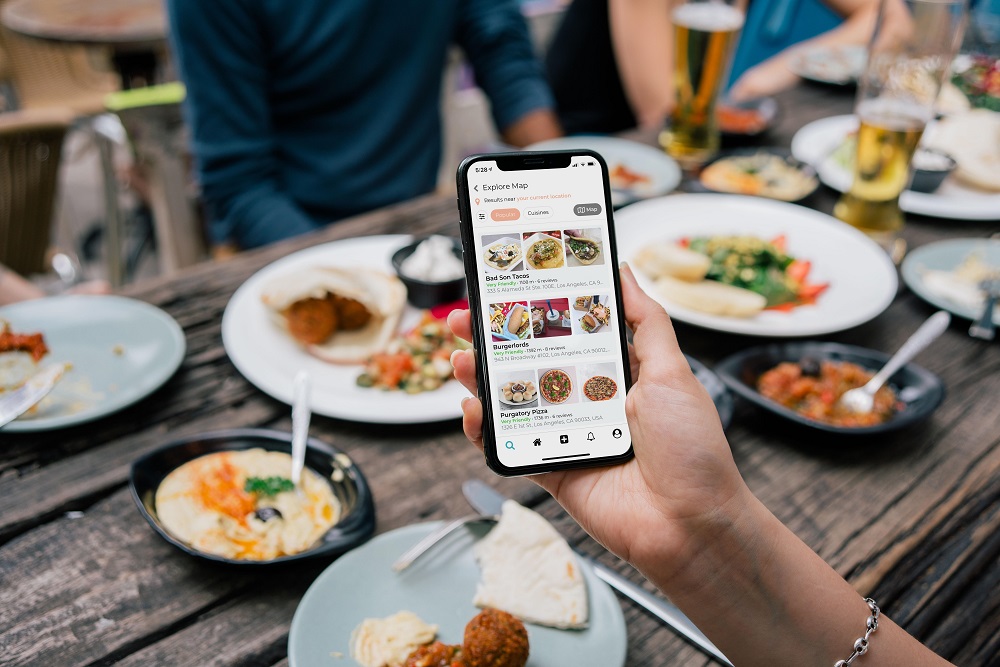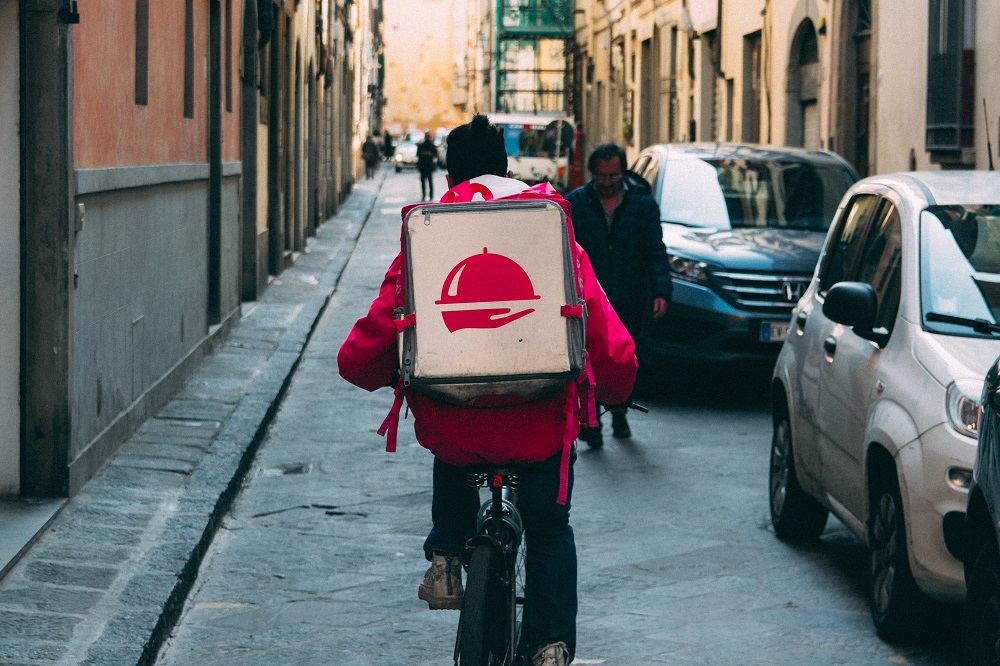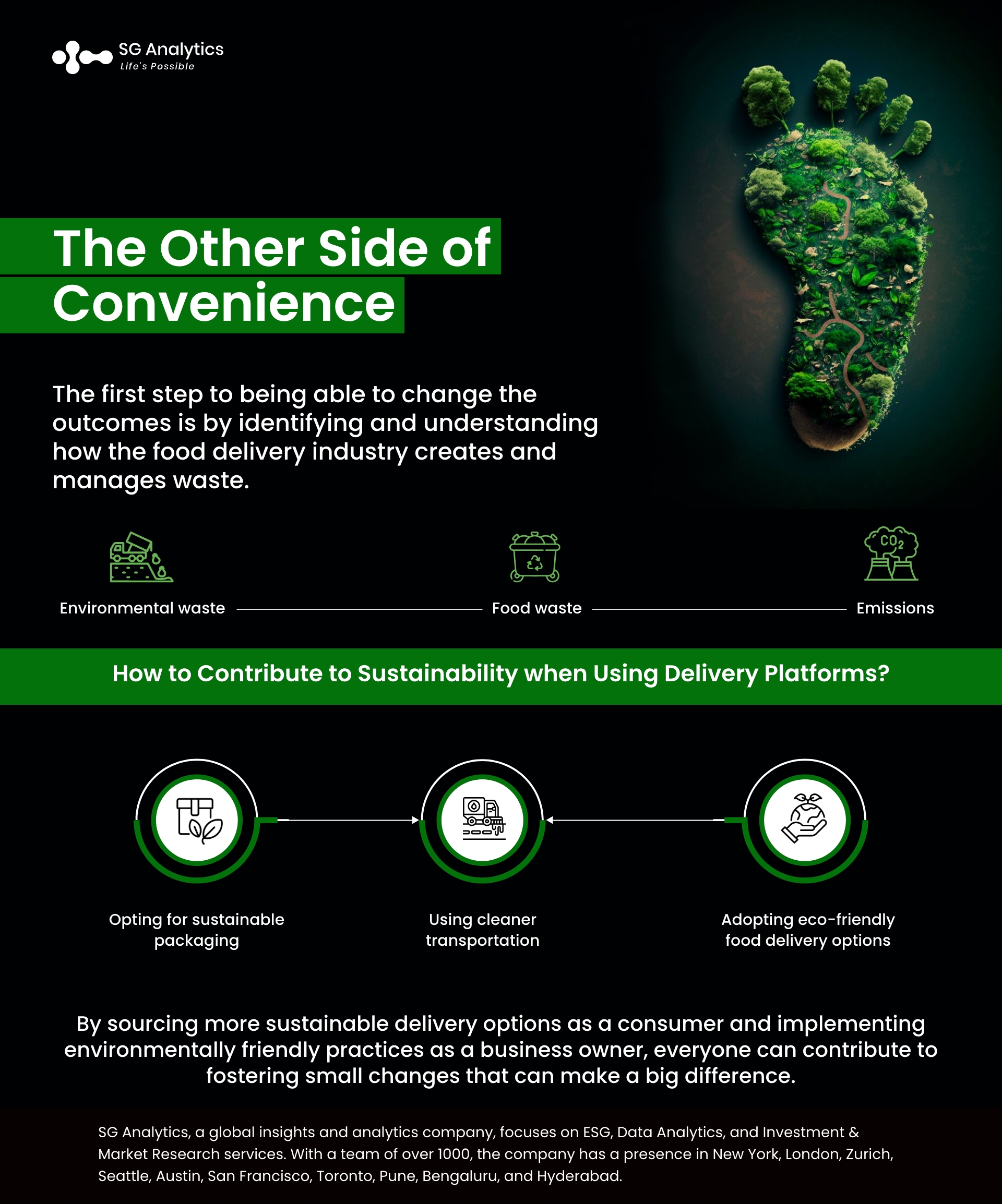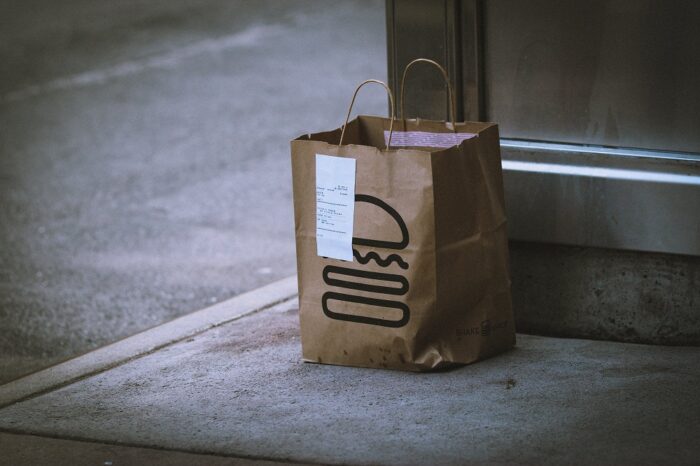Online food ordering and delivery systems have revolutionized the way we eat, putting convenience and a plethora of gastronomic choices at our fingertips. But food delivery is also leading to creating waste and increasing carbon emissions. And this convenience has an environmental cost.
The F&B, as well as the food delivery service industry, is finding itself in a tug of war as businesses are striving to increase profits while considering the shift toward sustainability. This onset will inevitably bring about operational changes. To tackle the crisis being faced by the industry, businesses are working to establish a balance between financial growth and environmental consciousness.
It is, therefore, critical to adopt behaviors that will help in reducing waste and the carbon footprint connected with online food delivery to secure a more sustainable future.
Read more: ESG Strategy for Growth: Embedding ESG in the Business Model

How is the Food Delivery System Impacting the Environment?
The convenience and accessibility of food delivery services are highly valued. Today the global online food delivery service is currently valued at $126.91 billion, and future projections for the industry continue to grow. The food delivery services are not only benefiting consumers but also restaurant owners by enabling them to partner with delivery apps or setting up their own delivery services.
However, this boom in the food delivery sector isn’t a net positive. There has been an increase in emissions from cars, unsustainable packaging, and excess food waste that are adding to the existing environmental problems. Food delivery apps are known to have a significant impact on the environment in two major ways –
- Food Waste
- Carbon Emissions
If changes are not made, it has been projected that carbon emissions from food delivery are likely to rise. And with different food delivery companies along with partner restaurants within those companies, it becomes critical for the industry as well as the consumers to make better-informed choices.
The first step to being able to change the outcomes is to identify how the delivery industry creates and manages waste.

-
Environmental Waste
Non-sustainable packaging used by food delivery is a huge contributor to environmental waste. Some of these materials, such as single-use plastics, do not biodegrade. This adds to the amount of solid waste generated by the average household. Solid waste also contributes to methane emissions.
Read more: ESG Investing Practices, Responsible Strategies, Progress, and Challenges: An Ultimate Guide
-
Food Waste
Reports have highlighted that restaurants generate around 33 million pounds of food waste per year. This includes food that is unfinished by customers, food that spoils, and food items that cannot be kept for more than 24 hours. And when it comes to food delivery platforms, there is no specific data yet on the amount of food waste generated. Despite being organic in nature, food waste has a critical impact on climate change. When food is wasted, so is the energy, water, and other resources that were used to grow it. And when food rots, it emits methane gas, which further contributes to the greenhouse effect.
-
Emissions
Transportation is considered one of the largest offenders of greenhouse gas emissions. The average passenger vehicle that can be employed by virtually any food delivery app emits around 4.6 metric tons of greenhouse gases every year. The food delivery industry poses a huge problem with carbon emissions. And the increasing use of transportation in connection with the increase in food delivery systems further poses a huge environmental problem.

How to Contribute to Sustainability when Using Delivery Platforms?
Even though food delivery produces a significant amount of waste, the image can be improved with the help of different sustainability practices. One of them is making use of electric bikes or drones, which will aid in improving the environmental impact of the delivery while reducing road safety issues.
However, there are many ways to enjoy the convenience of food delivery without sacrificing your environmental beliefs.
-
Opting for Sustainable Packaging
Restaurants can use eco-friendly packaging to cut down on waste. Studies have also highlighted that 54 percent of consumers prefer restaurants that provide minimum packaging in food delivery. Delivery apps have also started incorporating the option to remove cutlery to reduce their carbon footprint. Most restaurants are transitioning to biodegradable and sustainable packaging, such as providing eco-friendly cutlery with food packaging. By embracing the adoption of sustainable packaging in their restaurant menu, restaurants can contribute to the sustainability culture.
Read more: ESG Data: How is it Defining the Future of Sustainable Operations
-
Using Cleaner Transportation
Restaurants are increasingly embracing the use of cleaner delivery solutions by transitioning to electric vehicles. But the surge in on-demand deliveries has resulted in a higher number of vehicles on the roads in congested urban areas. Business owners are therefore exploring innovative solutions to mitigate these challenges and eliminate carbon emissions. Electric-powered vehicles are suitable for small orders but within a reasonable radius. At the same time, bicycles, e-bikes, and walking are also being employed by restaurants for local deliveries within short distances. In coming years, electric vehicles are set to become more accessible for delivery partners as they are poised to become the standard for deliveries.

Adopting Eco-Friendly Food Delivery Options
The regulation in the food delivery industry is tricky due to the nature of the business. And as a consumer, there are many ways to make greener choices without waiting for the restaurant to do it for you. Some of the best practices include:
- Look for Local Options: Select local restaurants and grocery stores and see if they offer eco-friendly delivery services. This will not only benefit local businesses but also will enable you to reduce the carbon emissions it takes to get the food delivered to you.
- Select Restaurants with Sustainable Packaging: Ordering from a restaurant that offers sustainable food packing, rather than plastic or styrofoam. This will help you enjoy a greener experience.
- Opt-out of Single-Use Plastics: Opt out of getting plastic silverware or straws with your food deliveries. If the good is being delivered to your home, select without adding more single-use plastics to your order. Another way to support green food delivery is opting for meal kits instead of single-meal delivery. This helps in getting multiple meals delivered at once through carbon-neutral delivery.
Read more: SFDR: Understanding EU’s Sustainable Finance Disclosure Regulation

Final Thoughts – Reduce Carbon Footprint & Food Waste
Food plays a critical part in our everyday routine, and convenience in food is a big priority. And food delivery apps today have altered our eating behavior. With the food delivery industry evolving, it is helping you connect with your favorite local restaurants for ordering organic food delivery or a take-out. The convenience of food delivery apps has caused consumers to order more food than their level of hunger. But this is leading to the generation of food waste, thus making it a grave societal problem. With this convenience, consumers are experiencing the guilt of food waste and increasing carbon footprint due to food delivery.
As a consumer, it is important to note that not every food delivery company will care about the environment – so choose wisely. Opt for sustainability-friendly options and check the company’s environmental policy. Another sustainability practice that can be incorporated by delivery restaurants is offering customers the option to opt-in for the necessary plastic cutlery and napkins.
By sourcing more sustainable delivery options as a consumer and implementing environmentally friendly practices as a business owner, everyone can contribute to fostering small changes that can make a big difference.
With a presence in New York, San Francisco, Austin, Seattle, Toronto, London, Zurich, Pune, Bengaluru, and Hyderabad, SG Analytics, a pioneer in Research and Analytics, offers tailor-made services to enterprises worldwide.
A leader in ESG Services, SG Analytics offers bespoke sustainability consulting services and research support for informed decision-making. Contact us today if you are in search of an efficient ESG (Environmental, Social, and Governance) integration and management solution provider to boost your sustainable performance.

